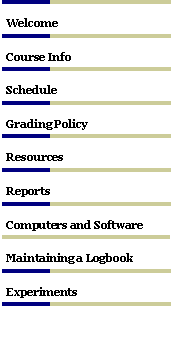

|
Maintaining a Logbook |
|
Logbook Rules
One of the most difficult things to learn, yet one of the most important for future success in physics research, is mastering the "art" of maintaining a proper log book. You should keep a detailed log of all your activities in the lab. Use a bound notebook, not loose sheets of paper. I prefer Gold Fibre Ampad item #22-156 available at Staples for less than $10 -- other equivalent bound notebooks are fine. Do not get the type with extra pages for carbon copies. Extra material, such as computer printout, photographs, etc., must be pasted or taped into the book. Make sure your logbook has numbered pages. A page size slightly large than 8.5” x 11” will allow you to tape in full size computer printouts.
•Skip the first page or two to use for a Table of Contents. •Start a new page for each experiment, but otherwise do not leave blank pages. If you have work to add from a previous experiment, just indicate this with a brief note ("Continued on page 57"). •Date every page, and record the time of the day for important time-sensitive entries, e.g., “turning on diffusion pump.” •Always write directly into your log; NEVER work on loose scraps of paper, and then copy things into the book. Even “mistakes” often turn out to be important! •For the same reason, do not use pencil. If you discover that something was wrong, "X" it out so that it is clearly marked as being in error, but is still legible. Never use white-out, paste over, or (worst of all) remove pages!
Logbook Guidelines
As far as deciding what should be entered into your log book, this is largely a matter of personal taste. Below are some guidelines.
•When you start a measurement, state briefly what its goal is -- just a few key phrases to remind yourself exactly what you will be trying to do. •As you go along, jot down enough information to indicate what you are doing at that moment. Remember to note the times. •Provide diagrams (sketches, electronic schematics) of the apparatus, with complete information on settings of controls and other relevant instrumental data. Where appropriate provide model numbers of equipment. Indicate where cable connections are made. As a rule of thumb, these should be sufficiently detailed that you (or someone else) would have no trouble reproducing your experimental setup if someone were to disconnect all of the wires. •All measurements should be recorded immediately and directly. Any necessary arithmetic (to convert your numbers to other units, to average two numbers, etc.) should be done in a second step, and also recorded. Remember to record the units for dimensioned quantities, and always estimate the uncertainties in any measured quantity. If data are compiled with a computer print the data table and insert into your logbook. Clearly indicate what formulas are used to derive any secondary information from the primary data, including the propagation of errors. •Any time your measurements result in a list of numbers (e.g., determining how a quantity y depends on the setting of x), you should immediately convert this information into a graph. This can be done with a computer or directly in your logbook. This will not only often provide some intuition about their correlation, but will usually allow you to spot quickly any departure from a smooth dependence, which might indicate a problem with the equipment or an error in that single measurement. •Review the guidelines for utilizing a computer with your logbook and adhere to them. •As soon as you finish collecting the data, present some preliminary conclusions: what worked, what didn't, and what else will need to be done to complete the analysis. This is a very important step -- it is easy to forget where you left off with an experiment. |
P451 Modern Physics Lab |